Analysis of Malaysia's Economy: Globalization, Trade, and Currency
VerifiedAdded on 2020/12/09
|14
|3279
|400
Report
AI Summary
This report provides a comprehensive analysis of Malaysia's economy, focusing on key aspects such as exchange rates, the impact of globalization on trade relations, and the balance of payments. It begins by defining Malaysia as an emerging economy and traces its economic development since gaining independence, highlighting the shift from an agricultural-based economy to a leading exporter of electronic equipment. The report examines the Malaysian Ringgit, its exchange rate fluctuations, and the influence of these rates on trade volume and competitiveness. It further explores the effects of globalization, including Malaysia's membership in international organizations and its trade relationships with countries like the United States and China. The benefits of globalization on Malaysia's trade relations, such as increased tourism and global marketing, are also discussed. Finally, the report covers the balance of payments, providing a fundamental understanding of Malaysia's trade and financial transactions with the rest of the world.
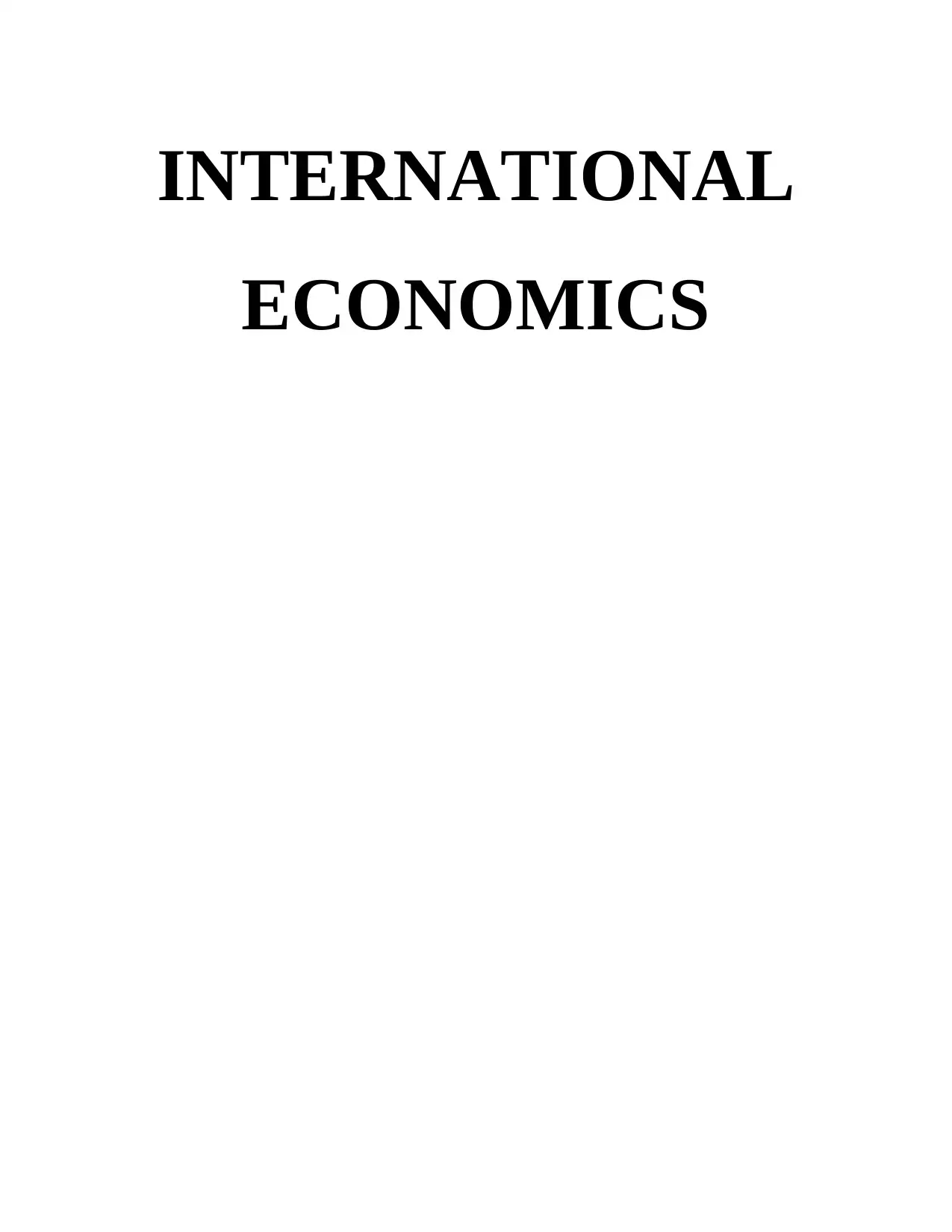
INTERNATIONAL
ECONOMICS
ECONOMICS
Paraphrase This Document
Need a fresh take? Get an instant paraphrase of this document with our AI Paraphraser
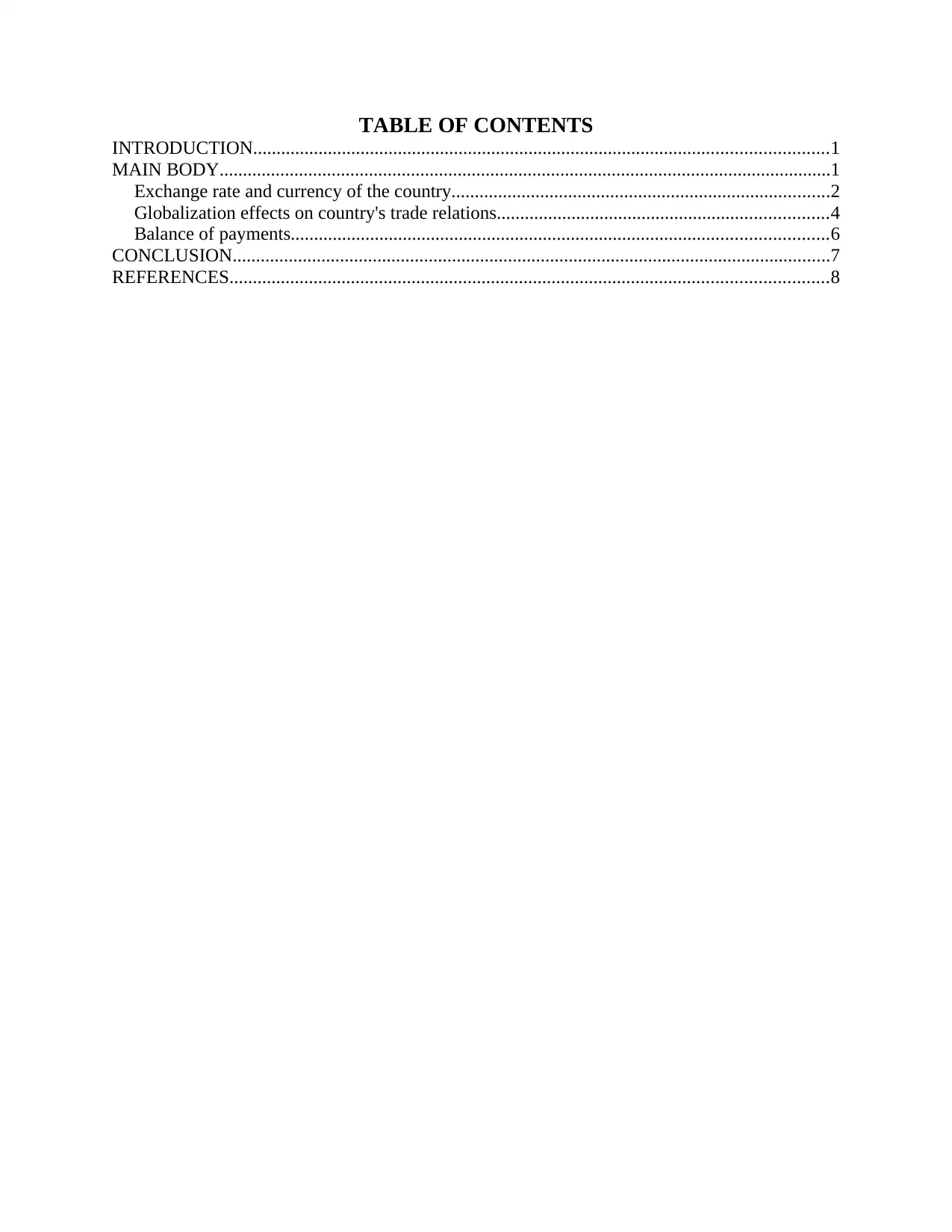
TABLE OF CONTENTS
INTRODUCTION...........................................................................................................................1
MAIN BODY...................................................................................................................................1
Exchange rate and currency of the country.................................................................................2
Globalization effects on country's trade relations.......................................................................4
Balance of payments...................................................................................................................6
CONCLUSION................................................................................................................................7
REFERENCES................................................................................................................................8
INTRODUCTION...........................................................................................................................1
MAIN BODY...................................................................................................................................1
Exchange rate and currency of the country.................................................................................2
Globalization effects on country's trade relations.......................................................................4
Balance of payments...................................................................................................................6
CONCLUSION................................................................................................................................7
REFERENCES................................................................................................................................8

ILLUSTRATION INDEX
Illustration 1: Exchange rate appreciation.......................................................................................3
Illustration 2: Export and import by sectors....................................................................................4
Illustration 3: Export partner of Malaysia........................................................................................5
Illustration 4: Malaysia and rest of the world..................................................................................6
Illustration 5: BoP of Malaysia in 1st Quarter of 2017....................................................................7
Illustration 6: Malaysia Current account from Jan 2015 to Jan 2018..............................................8
Illustration 1: Exchange rate appreciation.......................................................................................3
Illustration 2: Export and import by sectors....................................................................................4
Illustration 3: Export partner of Malaysia........................................................................................5
Illustration 4: Malaysia and rest of the world..................................................................................6
Illustration 5: BoP of Malaysia in 1st Quarter of 2017....................................................................7
Illustration 6: Malaysia Current account from Jan 2015 to Jan 2018..............................................8
⊘ This is a preview!⊘
Do you want full access?
Subscribe today to unlock all pages.

Trusted by 1+ million students worldwide
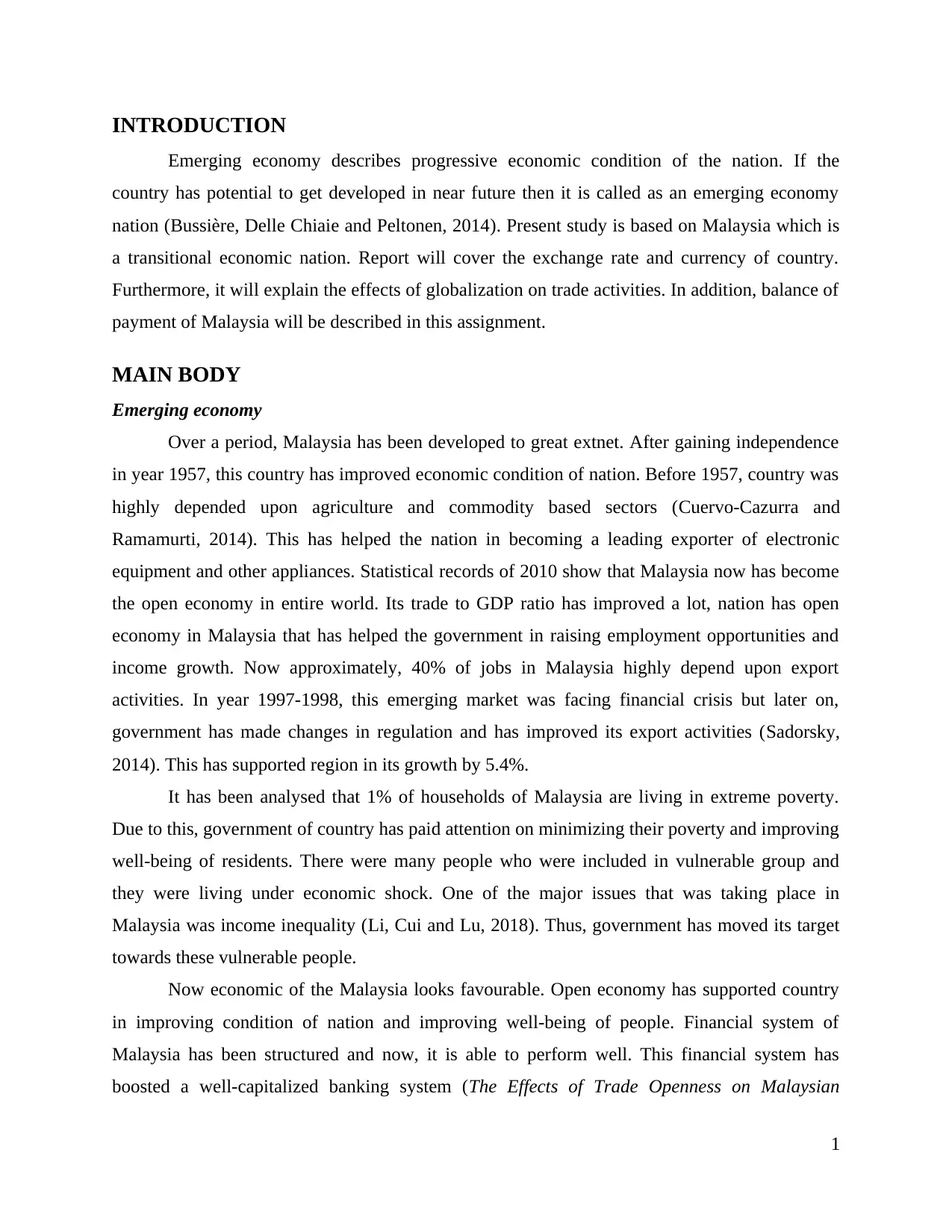
INTRODUCTION
Emerging economy describes progressive economic condition of the nation. If the
country has potential to get developed in near future then it is called as an emerging economy
nation (Bussière, Delle Chiaie and Peltonen, 2014). Present study is based on Malaysia which is
a transitional economic nation. Report will cover the exchange rate and currency of country.
Furthermore, it will explain the effects of globalization on trade activities. In addition, balance of
payment of Malaysia will be described in this assignment.
MAIN BODY
Emerging economy
Over a period, Malaysia has been developed to great extnet. After gaining independence
in year 1957, this country has improved economic condition of nation. Before 1957, country was
highly depended upon agriculture and commodity based sectors (Cuervo-Cazurra and
Ramamurti, 2014). This has helped the nation in becoming a leading exporter of electronic
equipment and other appliances. Statistical records of 2010 show that Malaysia now has become
the open economy in entire world. Its trade to GDP ratio has improved a lot, nation has open
economy in Malaysia that has helped the government in raising employment opportunities and
income growth. Now approximately, 40% of jobs in Malaysia highly depend upon export
activities. In year 1997-1998, this emerging market was facing financial crisis but later on,
government has made changes in regulation and has improved its export activities (Sadorsky,
2014). This has supported region in its growth by 5.4%.
It has been analysed that 1% of households of Malaysia are living in extreme poverty.
Due to this, government of country has paid attention on minimizing their poverty and improving
well-being of residents. There were many people who were included in vulnerable group and
they were living under economic shock. One of the major issues that was taking place in
Malaysia was income inequality (Li, Cui and Lu, 2018). Thus, government has moved its target
towards these vulnerable people.
Now economic of the Malaysia looks favourable. Open economy has supported country
in improving condition of nation and improving well-being of people. Financial system of
Malaysia has been structured and now, it is able to perform well. This financial system has
boosted a well-capitalized banking system (The Effects of Trade Openness on Malaysian
1
Emerging economy describes progressive economic condition of the nation. If the
country has potential to get developed in near future then it is called as an emerging economy
nation (Bussière, Delle Chiaie and Peltonen, 2014). Present study is based on Malaysia which is
a transitional economic nation. Report will cover the exchange rate and currency of country.
Furthermore, it will explain the effects of globalization on trade activities. In addition, balance of
payment of Malaysia will be described in this assignment.
MAIN BODY
Emerging economy
Over a period, Malaysia has been developed to great extnet. After gaining independence
in year 1957, this country has improved economic condition of nation. Before 1957, country was
highly depended upon agriculture and commodity based sectors (Cuervo-Cazurra and
Ramamurti, 2014). This has helped the nation in becoming a leading exporter of electronic
equipment and other appliances. Statistical records of 2010 show that Malaysia now has become
the open economy in entire world. Its trade to GDP ratio has improved a lot, nation has open
economy in Malaysia that has helped the government in raising employment opportunities and
income growth. Now approximately, 40% of jobs in Malaysia highly depend upon export
activities. In year 1997-1998, this emerging market was facing financial crisis but later on,
government has made changes in regulation and has improved its export activities (Sadorsky,
2014). This has supported region in its growth by 5.4%.
It has been analysed that 1% of households of Malaysia are living in extreme poverty.
Due to this, government of country has paid attention on minimizing their poverty and improving
well-being of residents. There were many people who were included in vulnerable group and
they were living under economic shock. One of the major issues that was taking place in
Malaysia was income inequality (Li, Cui and Lu, 2018). Thus, government has moved its target
towards these vulnerable people.
Now economic of the Malaysia looks favourable. Open economy has supported country
in improving condition of nation and improving well-being of people. Financial system of
Malaysia has been structured and now, it is able to perform well. This financial system has
boosted a well-capitalized banking system (The Effects of Trade Openness on Malaysian
1
Paraphrase This Document
Need a fresh take? Get an instant paraphrase of this document with our AI Paraphraser
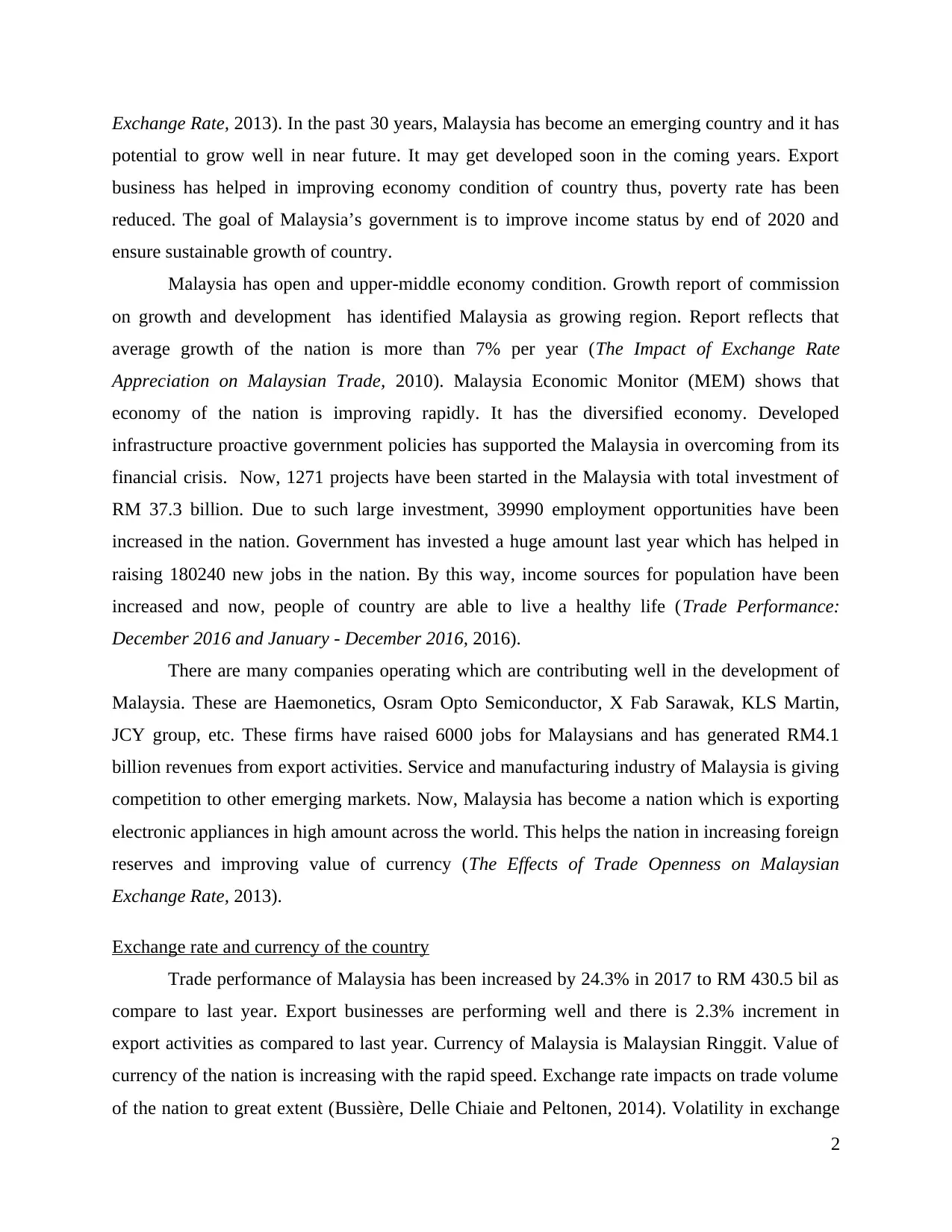
Exchange Rate, 2013). In the past 30 years, Malaysia has become an emerging country and it has
potential to grow well in near future. It may get developed soon in the coming years. Export
business has helped in improving economy condition of country thus, poverty rate has been
reduced. The goal of Malaysia’s government is to improve income status by end of 2020 and
ensure sustainable growth of country.
Malaysia has open and upper-middle economy condition. Growth report of commission
on growth and development has identified Malaysia as growing region. Report reflects that
average growth of the nation is more than 7% per year (The Impact of Exchange Rate
Appreciation on Malaysian Trade, 2010). Malaysia Economic Monitor (MEM) shows that
economy of the nation is improving rapidly. It has the diversified economy. Developed
infrastructure proactive government policies has supported the Malaysia in overcoming from its
financial crisis. Now, 1271 projects have been started in the Malaysia with total investment of
RM 37.3 billion. Due to such large investment, 39990 employment opportunities have been
increased in the nation. Government has invested a huge amount last year which has helped in
raising 180240 new jobs in the nation. By this way, income sources for population have been
increased and now, people of country are able to live a healthy life (Trade Performance:
December 2016 and January - December 2016, 2016).
There are many companies operating which are contributing well in the development of
Malaysia. These are Haemonetics, Osram Opto Semiconductor, X Fab Sarawak, KLS Martin,
JCY group, etc. These firms have raised 6000 jobs for Malaysians and has generated RM4.1
billion revenues from export activities. Service and manufacturing industry of Malaysia is giving
competition to other emerging markets. Now, Malaysia has become a nation which is exporting
electronic appliances in high amount across the world. This helps the nation in increasing foreign
reserves and improving value of currency (The Effects of Trade Openness on Malaysian
Exchange Rate, 2013).
Exchange rate and currency of the country
Trade performance of Malaysia has been increased by 24.3% in 2017 to RM 430.5 bil as
compare to last year. Export businesses are performing well and there is 2.3% increment in
export activities as compared to last year. Currency of Malaysia is Malaysian Ringgit. Value of
currency of the nation is increasing with the rapid speed. Exchange rate impacts on trade volume
of the nation to great extent (Bussière, Delle Chiaie and Peltonen, 2014). Volatility in exchange
2
potential to grow well in near future. It may get developed soon in the coming years. Export
business has helped in improving economy condition of country thus, poverty rate has been
reduced. The goal of Malaysia’s government is to improve income status by end of 2020 and
ensure sustainable growth of country.
Malaysia has open and upper-middle economy condition. Growth report of commission
on growth and development has identified Malaysia as growing region. Report reflects that
average growth of the nation is more than 7% per year (The Impact of Exchange Rate
Appreciation on Malaysian Trade, 2010). Malaysia Economic Monitor (MEM) shows that
economy of the nation is improving rapidly. It has the diversified economy. Developed
infrastructure proactive government policies has supported the Malaysia in overcoming from its
financial crisis. Now, 1271 projects have been started in the Malaysia with total investment of
RM 37.3 billion. Due to such large investment, 39990 employment opportunities have been
increased in the nation. Government has invested a huge amount last year which has helped in
raising 180240 new jobs in the nation. By this way, income sources for population have been
increased and now, people of country are able to live a healthy life (Trade Performance:
December 2016 and January - December 2016, 2016).
There are many companies operating which are contributing well in the development of
Malaysia. These are Haemonetics, Osram Opto Semiconductor, X Fab Sarawak, KLS Martin,
JCY group, etc. These firms have raised 6000 jobs for Malaysians and has generated RM4.1
billion revenues from export activities. Service and manufacturing industry of Malaysia is giving
competition to other emerging markets. Now, Malaysia has become a nation which is exporting
electronic appliances in high amount across the world. This helps the nation in increasing foreign
reserves and improving value of currency (The Effects of Trade Openness on Malaysian
Exchange Rate, 2013).
Exchange rate and currency of the country
Trade performance of Malaysia has been increased by 24.3% in 2017 to RM 430.5 bil as
compare to last year. Export businesses are performing well and there is 2.3% increment in
export activities as compared to last year. Currency of Malaysia is Malaysian Ringgit. Value of
currency of the nation is increasing with the rapid speed. Exchange rate impacts on trade volume
of the nation to great extent (Bussière, Delle Chiaie and Peltonen, 2014). Volatility in exchange
2
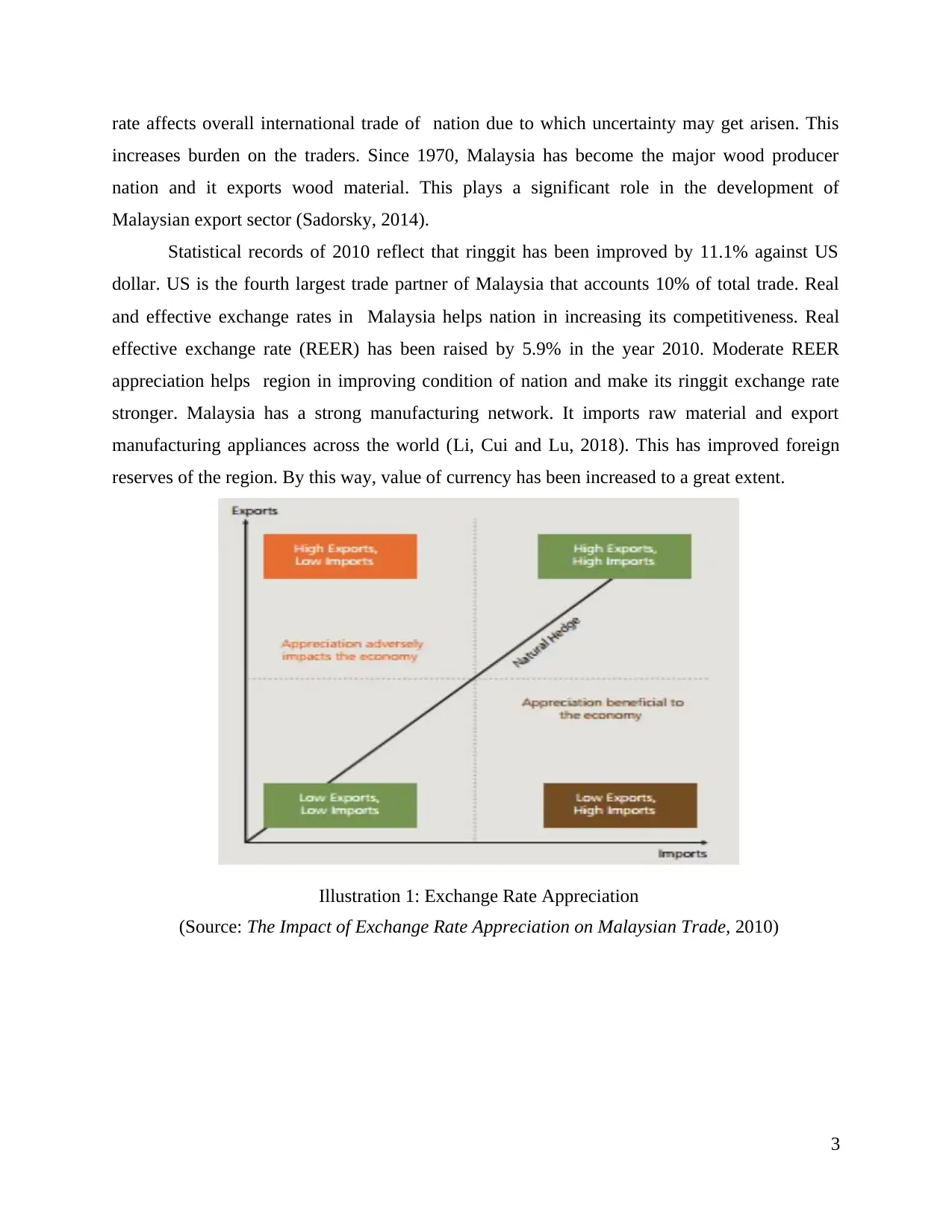
rate affects overall international trade of nation due to which uncertainty may get arisen. This
increases burden on the traders. Since 1970, Malaysia has become the major wood producer
nation and it exports wood material. This plays a significant role in the development of
Malaysian export sector (Sadorsky, 2014).
Statistical records of 2010 reflect that ringgit has been improved by 11.1% against US
dollar. US is the fourth largest trade partner of Malaysia that accounts 10% of total trade. Real
and effective exchange rates in Malaysia helps nation in increasing its competitiveness. Real
effective exchange rate (REER) has been raised by 5.9% in the year 2010. Moderate REER
appreciation helps region in improving condition of nation and make its ringgit exchange rate
stronger. Malaysia has a strong manufacturing network. It imports raw material and export
manufacturing appliances across the world (Li, Cui and Lu, 2018). This has improved foreign
reserves of the region. By this way, value of currency has been increased to a great extent.
Illustration 1: Exchange Rate Appreciation
(Source: The Impact of Exchange Rate Appreciation on Malaysian Trade, 2010)
3
increases burden on the traders. Since 1970, Malaysia has become the major wood producer
nation and it exports wood material. This plays a significant role in the development of
Malaysian export sector (Sadorsky, 2014).
Statistical records of 2010 reflect that ringgit has been improved by 11.1% against US
dollar. US is the fourth largest trade partner of Malaysia that accounts 10% of total trade. Real
and effective exchange rates in Malaysia helps nation in increasing its competitiveness. Real
effective exchange rate (REER) has been raised by 5.9% in the year 2010. Moderate REER
appreciation helps region in improving condition of nation and make its ringgit exchange rate
stronger. Malaysia has a strong manufacturing network. It imports raw material and export
manufacturing appliances across the world (Li, Cui and Lu, 2018). This has improved foreign
reserves of the region. By this way, value of currency has been increased to a great extent.
Illustration 1: Exchange Rate Appreciation
(Source: The Impact of Exchange Rate Appreciation on Malaysian Trade, 2010)
3
⊘ This is a preview!⊘
Do you want full access?
Subscribe today to unlock all pages.

Trusted by 1+ million students worldwide
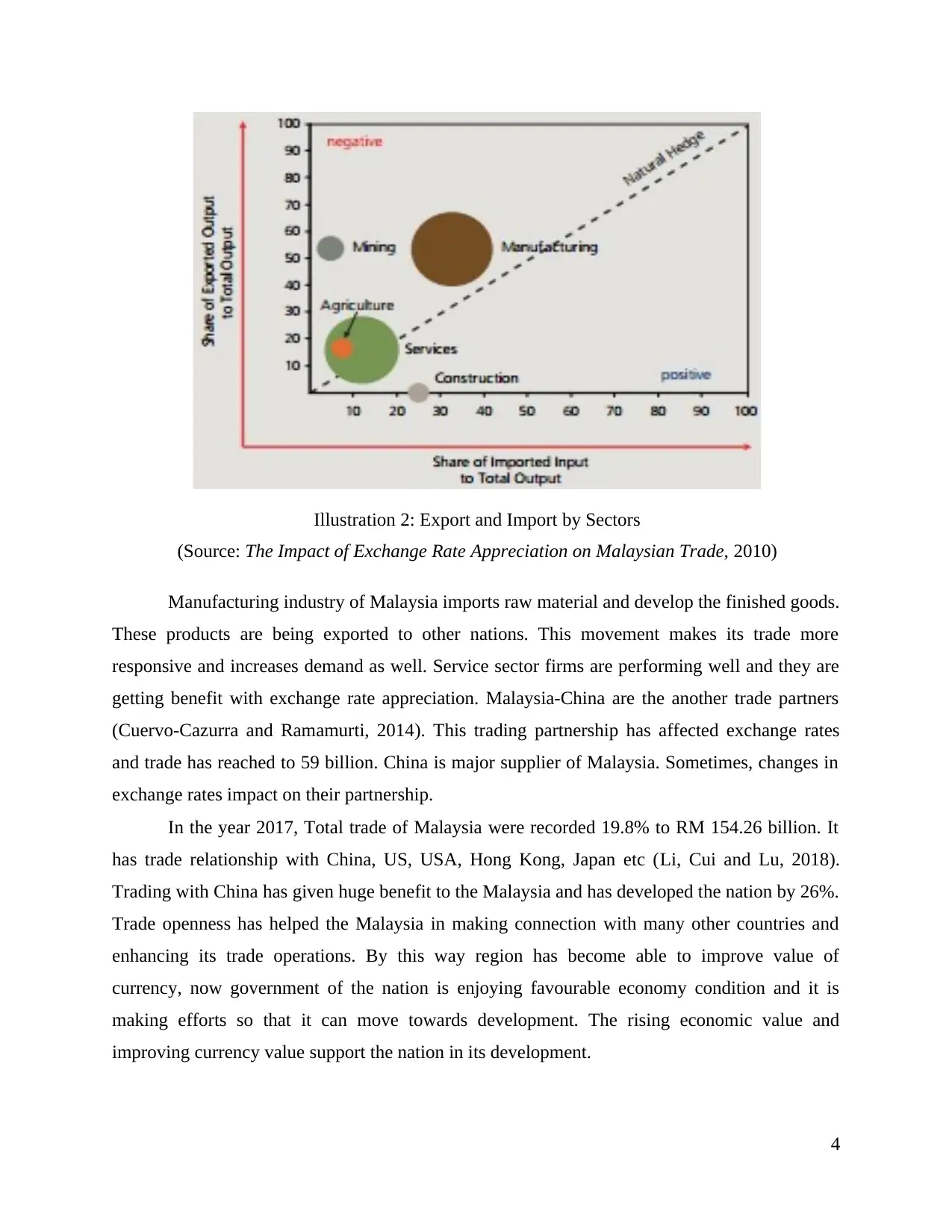
Illustration 2: Export and Import by Sectors
(Source: The Impact of Exchange Rate Appreciation on Malaysian Trade, 2010)
Manufacturing industry of Malaysia imports raw material and develop the finished goods.
These products are being exported to other nations. This movement makes its trade more
responsive and increases demand as well. Service sector firms are performing well and they are
getting benefit with exchange rate appreciation. Malaysia-China are the another trade partners
(Cuervo-Cazurra and Ramamurti, 2014). This trading partnership has affected exchange rates
and trade has reached to 59 billion. China is major supplier of Malaysia. Sometimes, changes in
exchange rates impact on their partnership.
In the year 2017, Total trade of Malaysia were recorded 19.8% to RM 154.26 billion. It
has trade relationship with China, US, USA, Hong Kong, Japan etc (Li, Cui and Lu, 2018).
Trading with China has given huge benefit to the Malaysia and has developed the nation by 26%.
Trade openness has helped the Malaysia in making connection with many other countries and
enhancing its trade operations. By this way region has become able to improve value of
currency, now government of the nation is enjoying favourable economy condition and it is
making efforts so that it can move towards development. The rising economic value and
improving currency value support the nation in its development.
4
(Source: The Impact of Exchange Rate Appreciation on Malaysian Trade, 2010)
Manufacturing industry of Malaysia imports raw material and develop the finished goods.
These products are being exported to other nations. This movement makes its trade more
responsive and increases demand as well. Service sector firms are performing well and they are
getting benefit with exchange rate appreciation. Malaysia-China are the another trade partners
(Cuervo-Cazurra and Ramamurti, 2014). This trading partnership has affected exchange rates
and trade has reached to 59 billion. China is major supplier of Malaysia. Sometimes, changes in
exchange rates impact on their partnership.
In the year 2017, Total trade of Malaysia were recorded 19.8% to RM 154.26 billion. It
has trade relationship with China, US, USA, Hong Kong, Japan etc (Li, Cui and Lu, 2018).
Trading with China has given huge benefit to the Malaysia and has developed the nation by 26%.
Trade openness has helped the Malaysia in making connection with many other countries and
enhancing its trade operations. By this way region has become able to improve value of
currency, now government of the nation is enjoying favourable economy condition and it is
making efforts so that it can move towards development. The rising economic value and
improving currency value support the nation in its development.
4
Paraphrase This Document
Need a fresh take? Get an instant paraphrase of this document with our AI Paraphraser
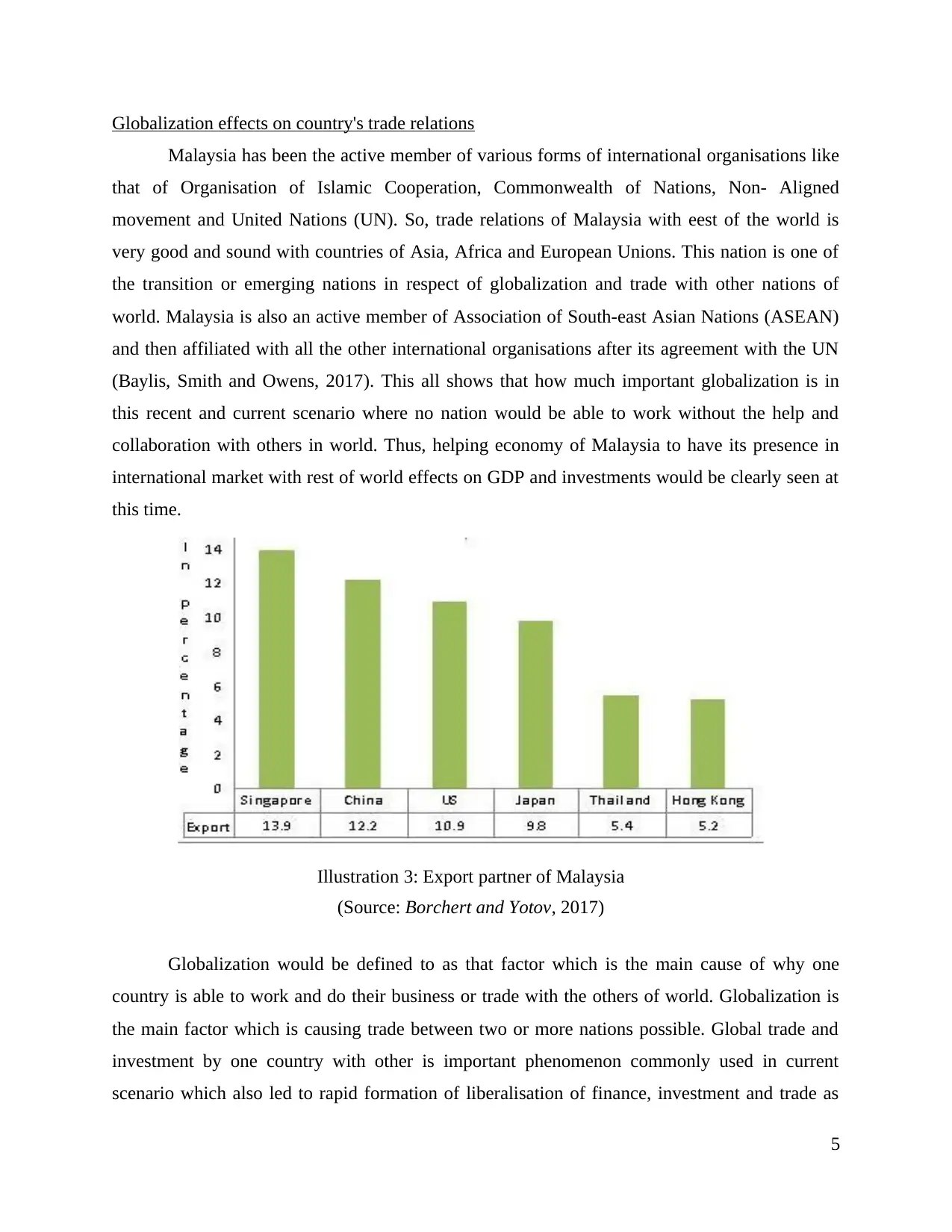
Globalization effects on country's trade relations
Malaysia has been the active member of various forms of international organisations like
that of Organisation of Islamic Cooperation, Commonwealth of Nations, Non- Aligned
movement and United Nations (UN). So, trade relations of Malaysia with eest of the world is
very good and sound with countries of Asia, Africa and European Unions. This nation is one of
the transition or emerging nations in respect of globalization and trade with other nations of
world. Malaysia is also an active member of Association of South-east Asian Nations (ASEAN)
and then affiliated with all the other international organisations after its agreement with the UN
(Baylis, Smith and Owens, 2017). This all shows that how much important globalization is in
this recent and current scenario where no nation would be able to work without the help and
collaboration with others in world. Thus, helping economy of Malaysia to have its presence in
international market with rest of world effects on GDP and investments would be clearly seen at
this time.
Globalization would be defined to as that factor which is the main cause of why one
country is able to work and do their business or trade with the others of world. Globalization is
the main factor which is causing trade between two or more nations possible. Global trade and
investment by one country with other is important phenomenon commonly used in current
scenario which also led to rapid formation of liberalisation of finance, investment and trade as
5
Illustration 3: Export partner of Malaysia
(Source: Borchert and Yotov, 2017)
Malaysia has been the active member of various forms of international organisations like
that of Organisation of Islamic Cooperation, Commonwealth of Nations, Non- Aligned
movement and United Nations (UN). So, trade relations of Malaysia with eest of the world is
very good and sound with countries of Asia, Africa and European Unions. This nation is one of
the transition or emerging nations in respect of globalization and trade with other nations of
world. Malaysia is also an active member of Association of South-east Asian Nations (ASEAN)
and then affiliated with all the other international organisations after its agreement with the UN
(Baylis, Smith and Owens, 2017). This all shows that how much important globalization is in
this recent and current scenario where no nation would be able to work without the help and
collaboration with others in world. Thus, helping economy of Malaysia to have its presence in
international market with rest of world effects on GDP and investments would be clearly seen at
this time.
Globalization would be defined to as that factor which is the main cause of why one
country is able to work and do their business or trade with the others of world. Globalization is
the main factor which is causing trade between two or more nations possible. Global trade and
investment by one country with other is important phenomenon commonly used in current
scenario which also led to rapid formation of liberalisation of finance, investment and trade as
5
Illustration 3: Export partner of Malaysia
(Source: Borchert and Yotov, 2017)
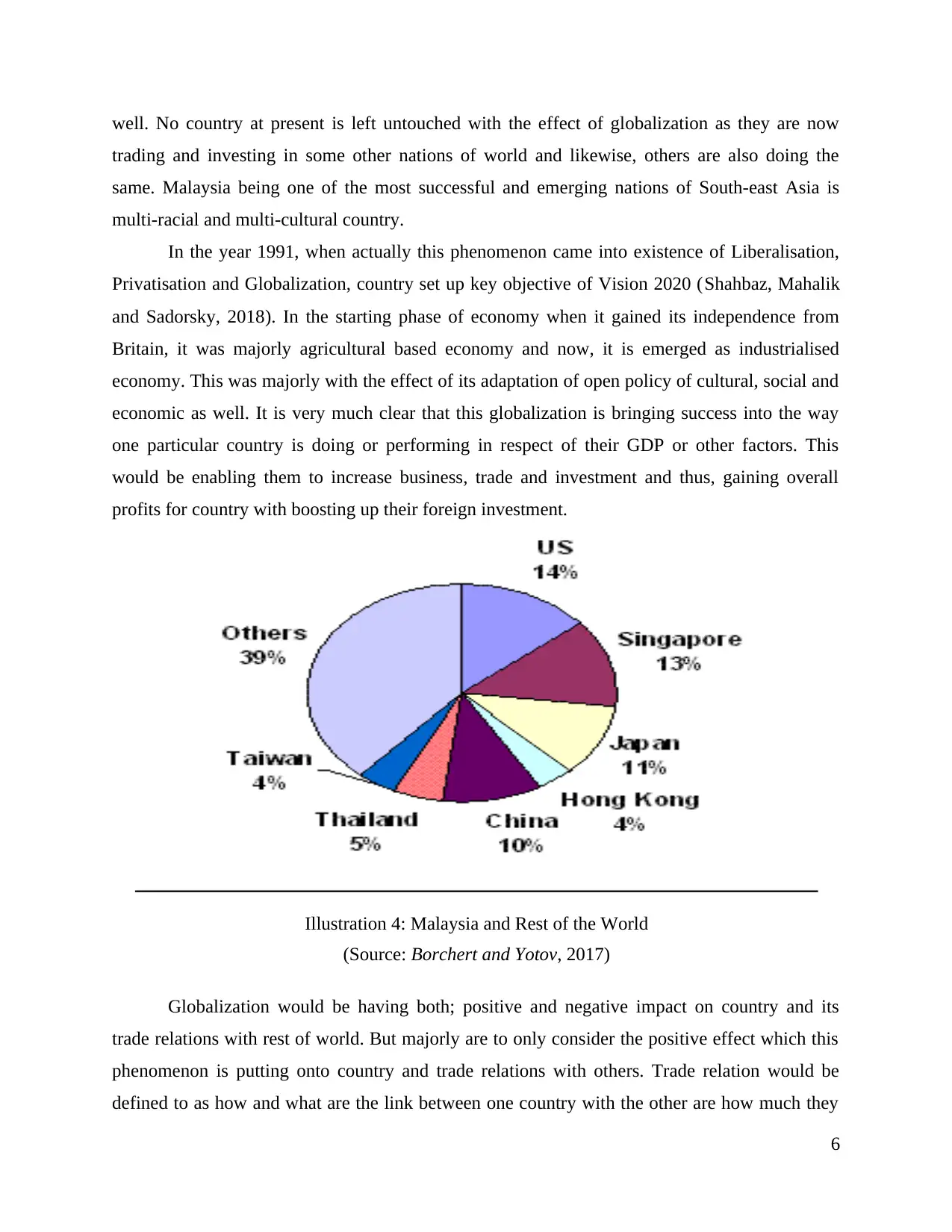
well. No country at present is left untouched with the effect of globalization as they are now
trading and investing in some other nations of world and likewise, others are also doing the
same. Malaysia being one of the most successful and emerging nations of South-east Asia is
multi-racial and multi-cultural country.
In the year 1991, when actually this phenomenon came into existence of Liberalisation,
Privatisation and Globalization, country set up key objective of Vision 2020 (Shahbaz, Mahalik
and Sadorsky, 2018). In the starting phase of economy when it gained its independence from
Britain, it was majorly agricultural based economy and now, it is emerged as industrialised
economy. This was majorly with the effect of its adaptation of open policy of cultural, social and
economic as well. It is very much clear that this globalization is bringing success into the way
one particular country is doing or performing in respect of their GDP or other factors. This
would be enabling them to increase business, trade and investment and thus, gaining overall
profits for country with boosting up their foreign investment.
Globalization would be having both; positive and negative impact on country and its
trade relations with rest of world. But majorly are to only consider the positive effect which this
phenomenon is putting onto country and trade relations with others. Trade relation would be
defined to as how and what are the link between one country with the other are how much they
6
Illustration 4: Malaysia and Rest of the World
(Source: Borchert and Yotov, 2017)
trading and investing in some other nations of world and likewise, others are also doing the
same. Malaysia being one of the most successful and emerging nations of South-east Asia is
multi-racial and multi-cultural country.
In the year 1991, when actually this phenomenon came into existence of Liberalisation,
Privatisation and Globalization, country set up key objective of Vision 2020 (Shahbaz, Mahalik
and Sadorsky, 2018). In the starting phase of economy when it gained its independence from
Britain, it was majorly agricultural based economy and now, it is emerged as industrialised
economy. This was majorly with the effect of its adaptation of open policy of cultural, social and
economic as well. It is very much clear that this globalization is bringing success into the way
one particular country is doing or performing in respect of their GDP or other factors. This
would be enabling them to increase business, trade and investment and thus, gaining overall
profits for country with boosting up their foreign investment.
Globalization would be having both; positive and negative impact on country and its
trade relations with rest of world. But majorly are to only consider the positive effect which this
phenomenon is putting onto country and trade relations with others. Trade relation would be
defined to as how and what are the link between one country with the other are how much they
6
Illustration 4: Malaysia and Rest of the World
(Source: Borchert and Yotov, 2017)
⊘ This is a preview!⊘
Do you want full access?
Subscribe today to unlock all pages.

Trusted by 1+ million students worldwide
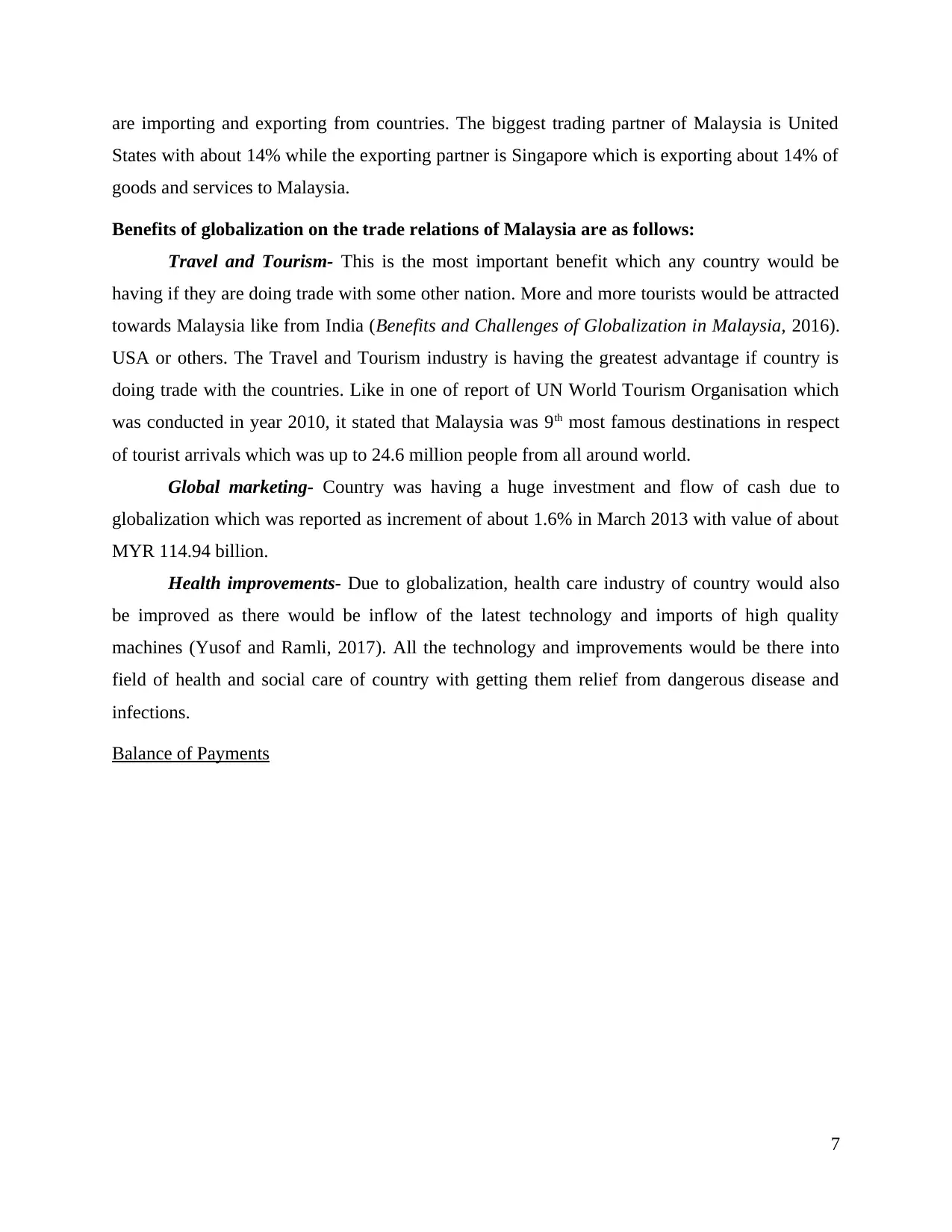
are importing and exporting from countries. The biggest trading partner of Malaysia is United
States with about 14% while the exporting partner is Singapore which is exporting about 14% of
goods and services to Malaysia.
Benefits of globalization on the trade relations of Malaysia are as follows:
Travel and Tourism- This is the most important benefit which any country would be
having if they are doing trade with some other nation. More and more tourists would be attracted
towards Malaysia like from India (Benefits and Challenges of Globalization in Malaysia, 2016).
USA or others. The Travel and Tourism industry is having the greatest advantage if country is
doing trade with the countries. Like in one of report of UN World Tourism Organisation which
was conducted in year 2010, it stated that Malaysia was 9th most famous destinations in respect
of tourist arrivals which was up to 24.6 million people from all around world.
Global marketing- Country was having a huge investment and flow of cash due to
globalization which was reported as increment of about 1.6% in March 2013 with value of about
MYR 114.94 billion.
Health improvements- Due to globalization, health care industry of country would also
be improved as there would be inflow of the latest technology and imports of high quality
machines (Yusof and Ramli, 2017). All the technology and improvements would be there into
field of health and social care of country with getting them relief from dangerous disease and
infections.
Balance of Payments
7
States with about 14% while the exporting partner is Singapore which is exporting about 14% of
goods and services to Malaysia.
Benefits of globalization on the trade relations of Malaysia are as follows:
Travel and Tourism- This is the most important benefit which any country would be
having if they are doing trade with some other nation. More and more tourists would be attracted
towards Malaysia like from India (Benefits and Challenges of Globalization in Malaysia, 2016).
USA or others. The Travel and Tourism industry is having the greatest advantage if country is
doing trade with the countries. Like in one of report of UN World Tourism Organisation which
was conducted in year 2010, it stated that Malaysia was 9th most famous destinations in respect
of tourist arrivals which was up to 24.6 million people from all around world.
Global marketing- Country was having a huge investment and flow of cash due to
globalization which was reported as increment of about 1.6% in March 2013 with value of about
MYR 114.94 billion.
Health improvements- Due to globalization, health care industry of country would also
be improved as there would be inflow of the latest technology and imports of high quality
machines (Yusof and Ramli, 2017). All the technology and improvements would be there into
field of health and social care of country with getting them relief from dangerous disease and
infections.
Balance of Payments
7
Paraphrase This Document
Need a fresh take? Get an instant paraphrase of this document with our AI Paraphraser
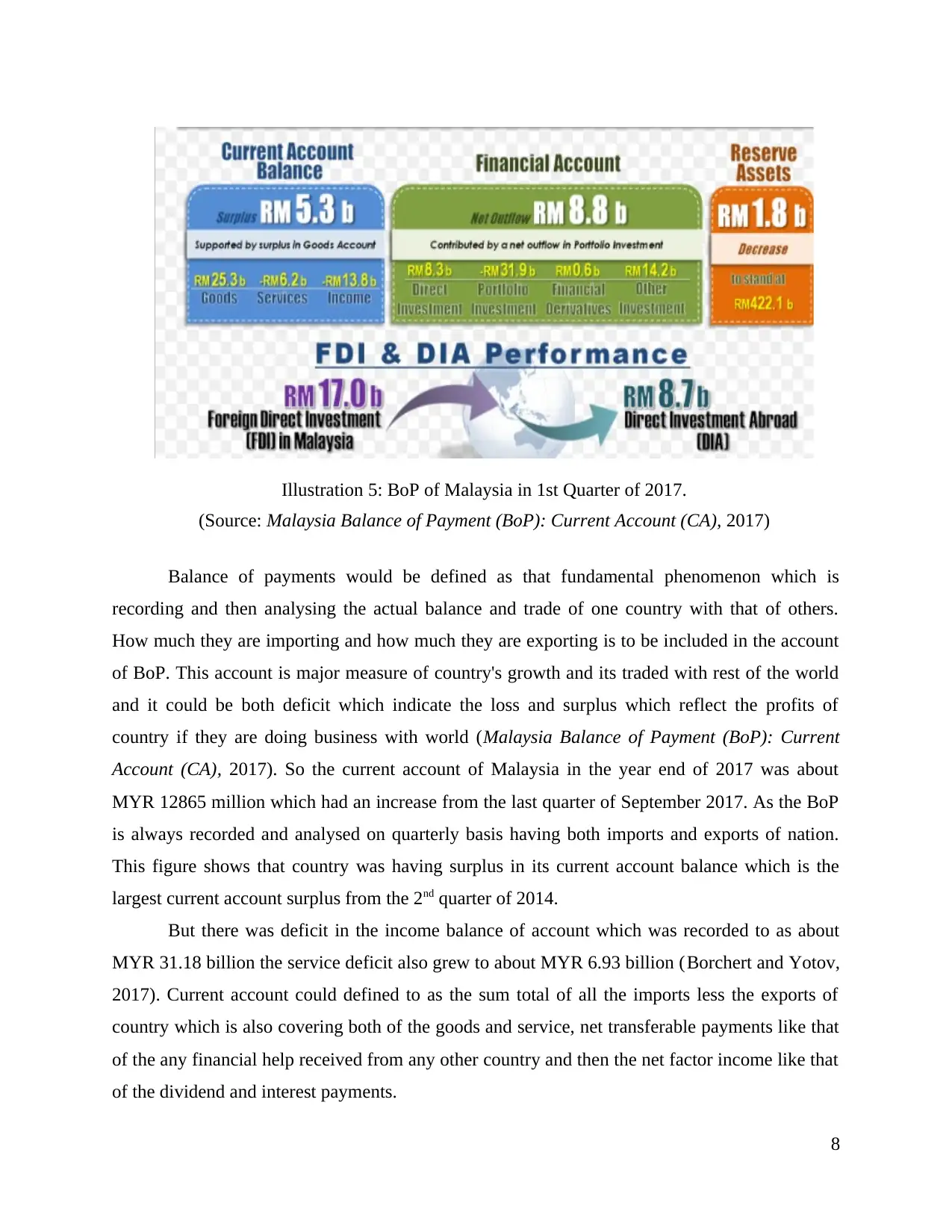
Balance of payments would be defined as that fundamental phenomenon which is
recording and then analysing the actual balance and trade of one country with that of others.
How much they are importing and how much they are exporting is to be included in the account
of BoP. This account is major measure of country's growth and its traded with rest of the world
and it could be both deficit which indicate the loss and surplus which reflect the profits of
country if they are doing business with world (Malaysia Balance of Payment (BoP): Current
Account (CA), 2017). So the current account of Malaysia in the year end of 2017 was about
MYR 12865 million which had an increase from the last quarter of September 2017. As the BoP
is always recorded and analysed on quarterly basis having both imports and exports of nation.
This figure shows that country was having surplus in its current account balance which is the
largest current account surplus from the 2nd quarter of 2014.
But there was deficit in the income balance of account which was recorded to as about
MYR 31.18 billion the service deficit also grew to about MYR 6.93 billion (Borchert and Yotov,
2017). Current account could defined to as the sum total of all the imports less the exports of
country which is also covering both of the goods and service, net transferable payments like that
of the any financial help received from any other country and then the net factor income like that
of the dividend and interest payments.
8
Illustration 5: BoP of Malaysia in 1st Quarter of 2017.
(Source: Malaysia Balance of Payment (BoP): Current Account (CA), 2017)
recording and then analysing the actual balance and trade of one country with that of others.
How much they are importing and how much they are exporting is to be included in the account
of BoP. This account is major measure of country's growth and its traded with rest of the world
and it could be both deficit which indicate the loss and surplus which reflect the profits of
country if they are doing business with world (Malaysia Balance of Payment (BoP): Current
Account (CA), 2017). So the current account of Malaysia in the year end of 2017 was about
MYR 12865 million which had an increase from the last quarter of September 2017. As the BoP
is always recorded and analysed on quarterly basis having both imports and exports of nation.
This figure shows that country was having surplus in its current account balance which is the
largest current account surplus from the 2nd quarter of 2014.
But there was deficit in the income balance of account which was recorded to as about
MYR 31.18 billion the service deficit also grew to about MYR 6.93 billion (Borchert and Yotov,
2017). Current account could defined to as the sum total of all the imports less the exports of
country which is also covering both of the goods and service, net transferable payments like that
of the any financial help received from any other country and then the net factor income like that
of the dividend and interest payments.
8
Illustration 5: BoP of Malaysia in 1st Quarter of 2017.
(Source: Malaysia Balance of Payment (BoP): Current Account (CA), 2017)
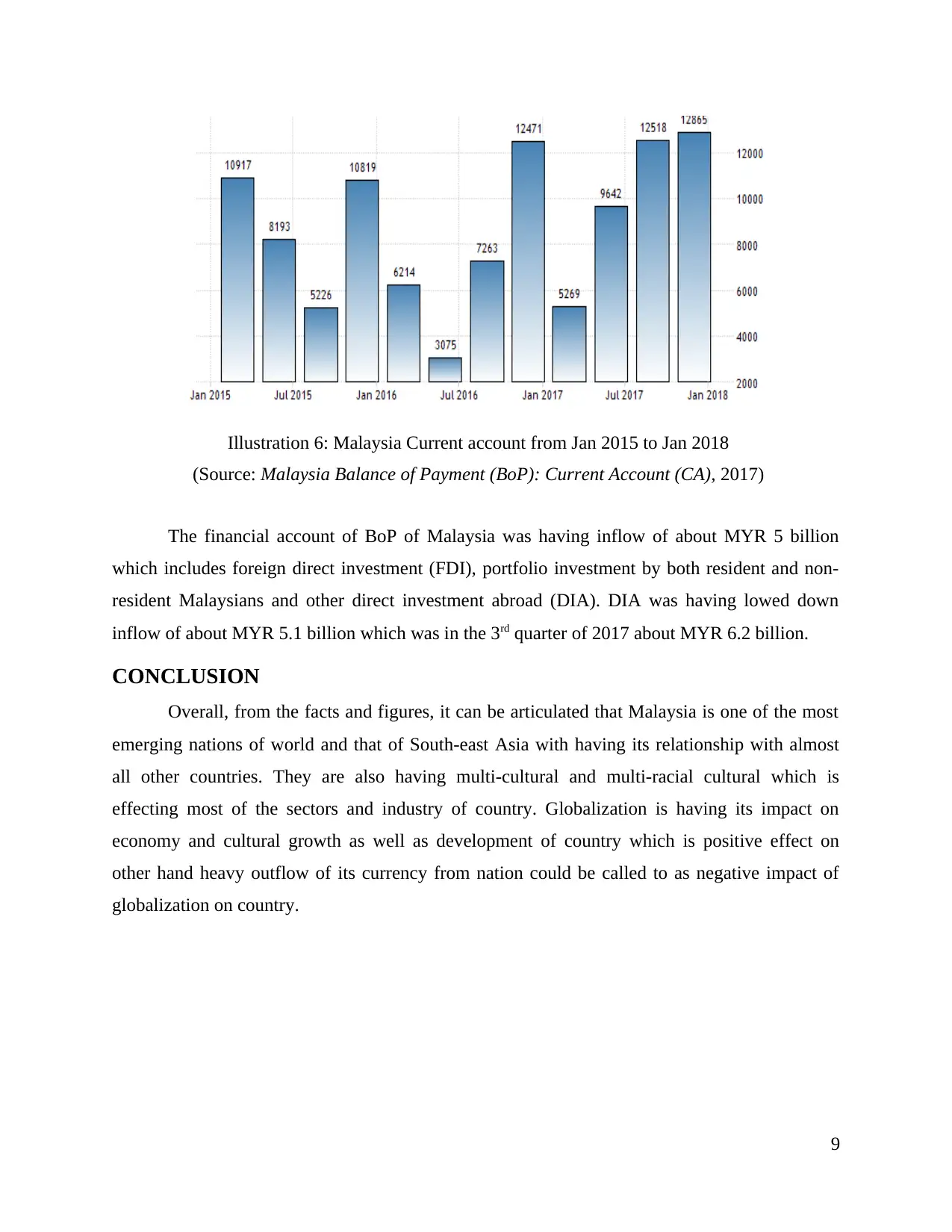
The financial account of BoP of Malaysia was having inflow of about MYR 5 billion
which includes foreign direct investment (FDI), portfolio investment by both resident and non-
resident Malaysians and other direct investment abroad (DIA). DIA was having lowed down
inflow of about MYR 5.1 billion which was in the 3rd quarter of 2017 about MYR 6.2 billion.
CONCLUSION
Overall, from the facts and figures, it can be articulated that Malaysia is one of the most
emerging nations of world and that of South-east Asia with having its relationship with almost
all other countries. They are also having multi-cultural and multi-racial cultural which is
effecting most of the sectors and industry of country. Globalization is having its impact on
economy and cultural growth as well as development of country which is positive effect on
other hand heavy outflow of its currency from nation could be called to as negative impact of
globalization on country.
9
Illustration 6: Malaysia Current account from Jan 2015 to Jan 2018
(Source: Malaysia Balance of Payment (BoP): Current Account (CA), 2017)
which includes foreign direct investment (FDI), portfolio investment by both resident and non-
resident Malaysians and other direct investment abroad (DIA). DIA was having lowed down
inflow of about MYR 5.1 billion which was in the 3rd quarter of 2017 about MYR 6.2 billion.
CONCLUSION
Overall, from the facts and figures, it can be articulated that Malaysia is one of the most
emerging nations of world and that of South-east Asia with having its relationship with almost
all other countries. They are also having multi-cultural and multi-racial cultural which is
effecting most of the sectors and industry of country. Globalization is having its impact on
economy and cultural growth as well as development of country which is positive effect on
other hand heavy outflow of its currency from nation could be called to as negative impact of
globalization on country.
9
Illustration 6: Malaysia Current account from Jan 2015 to Jan 2018
(Source: Malaysia Balance of Payment (BoP): Current Account (CA), 2017)
⊘ This is a preview!⊘
Do you want full access?
Subscribe today to unlock all pages.

Trusted by 1+ million students worldwide
1 out of 14
Related Documents
Your All-in-One AI-Powered Toolkit for Academic Success.
+13062052269
info@desklib.com
Available 24*7 on WhatsApp / Email
![[object Object]](/_next/static/media/star-bottom.7253800d.svg)
Unlock your academic potential
Copyright © 2020–2025 A2Z Services. All Rights Reserved. Developed and managed by ZUCOL.





